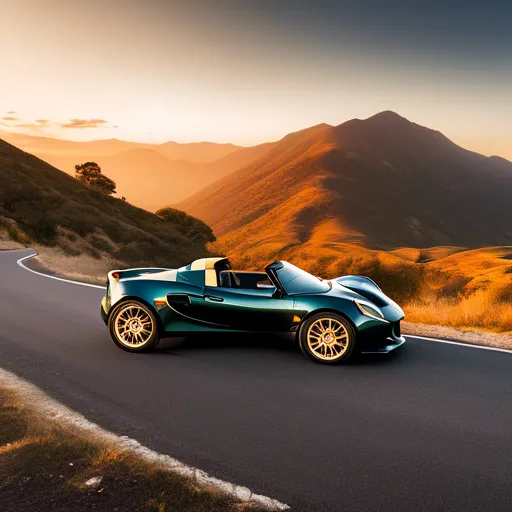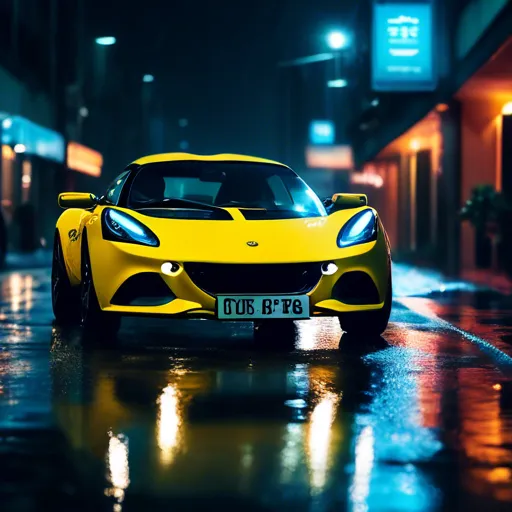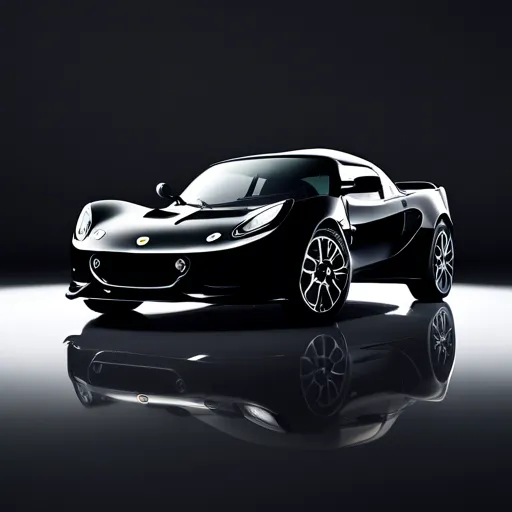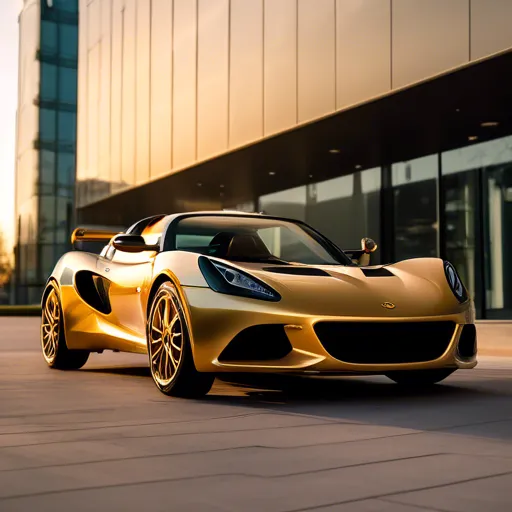
History of Lotus
The roots of the British automobile manufacturer Lotus date back to 1948. The company was founded by car enthusiast and engineer Colin Chapman in a small London garage. His vision: to build lightweight, high-performance cars. Chapman’s mantra “Simplify, then add lightness” was unmistakable, and continues to shape Lotus’s philosophy to this day.
The Founding Years and Formula 1 Successes
Chapman set new standards for his time by increasing the performance of his vehicles through weight reduction and aerodynamic improvements, rather than using larger engines. This approach led to Lotus’s rapid rise and success in prestigious motor races, such as Formula 1. With a total of seven world championships, Lotus is one of the most experienced and successful players in Formula 1 history.
Revolution in Vehicle Design
In the 1960s and 1970s, Lotus revolutionized the vehicle market with its innovative models. The most famous model is the Lotus Elan, which set new standards with its unique fiberglass monocoque design. The Elan was also the first car with disc brakes on all four wheels.
Changing Times
Despite financial difficulties in the 1990s, Lotus cemented its position as a high-quality car manufacturer by demonstrating continuity in innovative vehicle production. The Lotus Elise, another iconic sports car, for example, was introduced in 1996 and remains one of the company’s most recognizable models. Lotus’s history is one of tireless passion and continuous innovation. It demonstrates that by striving for excellence and continuous progress, a lasting impact on the automotive industry can be made.
Lotus Today
Lotus, as one of the long-standing and renowned vehicle manufacturers from Great Britain, has secured a unique place for itself in today’s automotive world. Known for its lightweight and agile sports cars, the company continues to rely on its core competencies to survive in a highly competitive market.
Company Structure and Locations
Lotus Cars now operates as a subsidiary of Geely, a Chinese multinational car manufacturer. Although it belongs to the Chinese group, it is still based in Hethel, Great Britain.
Current Vehicle Models and Market Presence
Lotus’s current portfolio includes models such as the Elise, the Evora, and the Exige, which perfectly represent the company’s DNA—performance through lightweight construction. These models have impressed key markets such as the UK, Europe, and North America. Despite the stiff competition in the sports car segment, Lotus consistently leads the field in terms of customer popularity and on-road presence. But Lotus isn’t just looking to the present. The company has already unveiled its first all-electric hypercar, called the Evija, which not only demonstrates the company’s strategy regarding electromobility, but also its ambition to remain at the forefront of technology and innovation in the automotive sector.
Market Share and Economic Performance
Although Lotus generally produces fewer vehicles than some of its larger competitors, the company’s success cannot be measured solely by sales figures. Rather, the focus is on quality and perfection, as befits a manufacturer with its origins in the world of motorsport. Regardless, it is important to note that Lotus has aggressive growth plans. With investments in new technologies and expansion plans into Asia, the company aims to increase its global market share.
Challenges and Outlook
Despite its successes, Lotus, like all other car manufacturers, faces numerous challenges. The rapid development in the automotive industry, especially with regard to electromobility and digitalization, requires continuous adaptation and optimization of business models. However, Lotus’s unwavering focus on innovation and continuous improvement promises that the company will be able to meet these challenges and continue to produce fascinating and desirable vehicles.
Lotus Vehicle Classes
Throughout its history, the Lotus brand has always placed emphasis on producing high-quality and specialized vehicle models. As a brand focused on performance and driving dynamics, Lotus has developed a number of unique vehicle classes that represent its specific values.
Sports Cars as a Core Element
Perhaps the most well-known aspect of the Lotus product line underscores its commitment to building high-performance sports cars. With models such as the Elise and the Exige, Lotus has created lightweight and powerful sports cars that are equally at home on the road and the racetrack. These cars are known for their precise handling and excellent performance, and they symbolize Lotus’s core philosophy of delivering maximum driving pleasure through weight reduction.
Luxury Grand Tourers
In addition to purist sports cars, Lotus has also made its mark on the grand tourer class. The Lotus Evora, for example, offers an excellent blend of luxury and performance, making it an ideal choice for long-distance driving. It offers enough comfort and amenities to satisfy the most demanding drivers, while maintaining the driver-focused performance for which Lotus is known.
The Future of Lotus Car Classes
In light of current trends in the automotive industry, Lotus is also moving in a new direction. With the Lotus Evija, the brand’s first all-electric hypercar, Lotus has shown that it is ready to adapt its traditional car classes to the future. Going electric is a bold and exciting step and underlines Lotus’s commitment to using innovative and sustainable technologies across its vehicle range. This model also suggests that future Lotus car classes could increasingly embrace electrification without losing their renowned sportiness and performance. Lotus’s ability to stay ahead of industry demands is a key factor in ensuring they continue to produce high-performance vehicles and maintain their unique position in the world of premium car manufacturers. Their car classes always reflect the pulse of the times while remaining true to their unique heritage. Regardless of the direction Lotus’s vehicle classes will develop in the future, one thing remains unchanged: the goal of offering an unparalleled driving experience.
Innovation and Technology at Lotus
The automotive industry is facing a time of change and challenges. New technologies bring innovative possibilities to the market while simultaneously placing high demands on car manufacturers. Lotus, a renowned British manufacturer of sports and racing cars, is addressing these challenges and driving innovation in the industry.
E-Mobility at Lotus
One of the key challenges facing today’s automotive industry is electromobility. With increasing awareness of climate change, electric cars are becoming the focus of attention. Lotus is aware of this responsibility and is setting standards with its new “Evija” vehicle. This all-electric hypercar is not only a testament to Lotus’s technical expertise but also a pioneer in sustainability.
Artificial Intelligence and Autonomous Driving
Autonomous driving and artificial intelligence (AI) are no longer just a thing of the future; they are reality. At Lotus, AI plays a crucial role in the development of new car models. On the one hand, AI enables the improvement of vehicle safety through driver assistance systems. On the other hand, it opens up opportunities to increase efficiency and performance.
Connected Vehicles and IoT
The Internet of Things (IoT) opens up completely new possibilities in the automotive sector. Connected vehicles offer drivers a greater level of comfort, safety, and efficiency. Lotus recognizes this potential and uses IoT to collect real-time data, for example, which can be used to optimize driving behavior and performance.
3D Printing in Automotive Manufacturing
The integration of 3D printing technologies into the vehicle manufacturing process enables accelerated, cost-effective, and precise production. Lotus is a leader in the implementation of this innovative process, which not only shortens the time to market for new models but also enables customized customization quickly and efficiently.
Virtual Reality in the Automotive Industry
The application of virtual reality (VR) and augmented reality (AR) in the automotive industry is another area in which Lotus is pioneering work. These technologies allow engineers to develop and test new vehicle models in a virtual environment, saving both time and money. Lotus’s mission is to develop vehicles that delight their drivers. The extensive innovations and technologies the company employs are clear evidence of this. Lotus is ready to take on the challenges of the future and will continue to cement its place at the forefront of the automotive industry.
Lotus and Sustainability
Sustainability plays an increasingly important role in today’s society. This trend is also increasingly in focus in the automotive industry. Those who appreciate the beauty and performance of vehicles like Lotus will be particularly pleased to know that the brand places great emphasis on sustainability.
Clean Production
Lotus’s production processes are focused on cleanliness and energy efficiency. The vehicles are produced under the strictest environmental regulations. These include emissions controls and the efficient use of resources to keep the ecological footprint as small as possible.
Sustainable Materials
Lotus’s commitment to the environment is also reflected in its choice of materials. In addition to lightweight construction, which minimizes fuel consumption and CO2 emissions, the brand increasingly uses sustainable materials. Recycled and recyclable materials are used wherever possible and appropriate.
Electric Mobility
An important aspect of Lotus’s sustainability strategy is electric mobility. The brand is committed to fully electrifying its product range. This is not only for environmental reasons, but also to enhance the driving experience, as electric powertrains are powerful and offer immediate responses. Lotus is investing heavily in the development of electric vehicles and the expansion of the necessary infrastructure. With ambitious targets and the introduction of plug-in hybrid and fully electric models, Lotus is paving the way for a sustainable future in the automotive industry. The movement towards sustainability is a fundamental commitment of Lotus. It goes far beyond mere compliance and encompasses all aspects of the company, from production to the products themselves to the corporate culture. It is not only a promise to the environment, but also a commitment to customers, employees and all other stakeholders associated with the Lotus brand.
Used Car Market Analysis for Lotus
The automotive market for used Lotus vehicles is a specific and unique segment that requires a thorough and comprehensive market analysis. It is important to have a clear understanding of the various factors that influence one’s transactions and make the sale or purchase of used Lotus vehicles profitable.
Demand for Used Lotus Vehicles
There is generally high demand for used Lotus cars, supported by their outstanding quality, performance, and the unique driving experience they offer. These vehicles are known for their reliability and durability, which makes them very attractive to buyers in the used car market.
Used Lotus Supply Locally and Online
The market for used Lotus vehicles varies regionally. Availability may be higher in some areas than in others. Digital platforms have made it much easier to access and sell used Lotus vehicles. They not only provide an easy way to showcase available vehicles but also enable a quick and secure transaction process.
Used Lotus Pricing
Pricing is a key factor in buying and selling used cars. The value of a used Lotus can vary greatly and depends on factors such as the model, age of the vehicle, mileage, condition, and service history. A comprehensive understanding and consideration of these factors is crucial for effectively trading used Lotus vehicles.
Trends and Forecasts
Continuously monitoring and analyzing trends and forecasts when dealing with used Lotus vehicles can help anticipate future changes in the used car market and make strategic decisions accordingly. By understanding the specific market and the ins and outs of buying and selling used Lotus cars, you can achieve optimal results. Data-driven market analysis allows you to efficiently manage your inventory and optimize your trading strategies based on real market conditions.
Purchasing Used Lotus Vehicles
The purchase of used vehicles plays an essential role in any well-functioning car dealership. This process involves acquiring used automobiles directly from the owner or another car dealer. It is an active process that requires considerable expertise. In the context of Lotus vehicles, this process has its own specific characteristics and advantages.
Advantages of Purchasing
The direct purchase of used Lotus vehicles offers several advantages. First, it opens up the opportunity to acquire unique or particularly desired models. Compared to purchasing—a more passive process in which the vehicle ends up at the dealership, whether through a trade-in or other circumstances—you have control and can specifically search for specific models. Second, purchasing involves direct contact with the seller of the car. This provides the opportunity to learn more about the car’s history and condition. In the case of Lotus, a brand often treated and maintained particularly well by its owners, this knowledge can be very valuable. Furthermore, purchasing a used Lotus can also be economically attractive. Although the initial cost may be higher than with a separate purchase, there is more scope for price negotiations. At the same time, after the purchase and any necessary refurbishment, the car can often be sold with a higher profit margin.
Buying a Lotus: A Question of Expertise
It is important to emphasize that purchasing used Lotus vehicles requires a certain level of expertise. Lotus is a brand with a unique history and a distinctive vehicle portfolio. Therefore, you must be well-versed in this field and have a thorough understanding of the market for used Lotus vehicles. Nevertheless, with the right preparation and expertise, purchasing used Lotus vehicles directly can be a worthwhile investment, increasing both the diversity and quality of your vehicle inventory and appealing to new customer groups. Overall, there are many reasons to favor purchasing used Lotus vehicles.
Purchasing Used Lotus Vehicles
In the fast-moving car retail industry, it can be crucial to dynamically adapt your vehicle inventory to your customers’ needs and current market trends. One strategy for achieving this is the purchase of used vehicles. Especially in the context of the Lotus car brand, purchasing represents a particularly attractive option.
The Strategic Aspect of Purchasing
Purchasing used Lotus vehicles is more than just adding more cars to your inventory. It is a strategic process aimed at filling specific gaps in your range or responding to specific customer requirements. You are able to specifically select vehicles that fit both your current offering and your customers’ needs. Whether you are looking for a specific model that is missing from your inventory or a specific feature, purchasing allows you to react and expand and improve your range accordingly.
The Advantages of Buying vs. Purchasing
When buying, you typically acquire a vehicle directly from a private individual. While this could have the advantage of securing a bargain, it can also involve significant risks. You have no guarantee of the vehicle’s technical condition, and since private sellers are often emotionally attached to their car, buying it could lead to price negotiations that don’t always work in your favor. However, buying from other dealers, fleets, or auctions brings several clear advantages. You often have a wider selection of vehicles, can specify more specific requirements, and have greater certainty regarding the vehicles’ technical condition, especially if they come from a fleet or auction with high standards.
The Lucrative Used Market for Lotus
The British car brand Lotus already has a loyal following, not least because of its lightweight, driver-focused sports cars that deliver impressive performance both on the road and on the racetrack. They are particularly known for their excellent handling and unique design. Therefore, the used market for Lotus vehicles is very lively and offers excellent sales opportunities. All in all, purchasing used Lotus vehicles is an excellent way to refresh your inventory and adapt to current market and customer trends. It offers you a strategic opportunity to expand your inventory both qualitatively and quantitatively, thus increasing your sales.
Standing Times at Car Dealers for Used Lotus Vehicles
As a car professional, you know the importance of standing times. The longer a vehicle sits in your yard, the higher the costs you incur. For used Lotus vehicles, standing times can vary depending on the model, condition, and price.
Factors Influencing Standing Times
A significant factor influencing the standing times of used Lotus vehicles is, of course, the condition of the vehicle itself. A Lotus that is in excellent condition, with regular maintenance and perhaps even with rarer features or a limited edition, can sell more quickly than one that shows signs of heavy wear or is due for major repairs. The specific model also plays a role here. Some models, such as the Lotus Elise or the Lotus Evora, are sought after by car enthusiasts and may therefore change hands more quickly. Another important factor is price. A properly excellent price can get the car off the lot more quickly. It’s important to feel the pulse of the market and adjust the price accordingly.
Reducing Idle Time
Many car dealers use various strategies to minimize the idle time of used Lotus vehicles. One such strategy might be to advertise vehicles through various online and offline platforms to reach a larger group of buyers. Detailed and engaging vehicle descriptions, as well as high-quality photos, can pique the interest of potential buyers and expedite the sales process. An effective pricing strategy can also be helpful. You could consider adjusting the price after a certain period of idle time to increase the vehicle’s desirability. Ultimately, it’s all about finding a balance between minimizing idle time and maximizing profit. Finally, the key to maintaining reasonable idle times for used Lotus vehicles is carefully monitoring the condition and popularity of different models, as well as selling prices, in the market. With the right tools and strategies, effective management of used Lotus vehicle idle time can be achieved.
FAQ
What should I look for when buying a used Lotus?
When considering a used Lotus, focus on the vehicle’s service history, rigorous maintenance records, and any signs of previous accidents. Inspecting the condition of key components like the engine, suspension, and brakes is essential. Additionally, researching ownership reviews can provide insights into reliability and common issues associated with specific models.
Are there particular models of Lotus that are more reliable than others?
Certain models have built a reputation for enhanced reliability; for example, the Lotus Elise is often praised for its lightweight design and simplicity in engineering. However, it’s vital to read model-specific reviews and forums since newer iterations may introduce different dynamics related to performance and upkeep.
How can I assess whether a used Lotus is fairly priced?
The best way to gauge fair pricing on a used Lotus is by comparing similar listings on various platforms such as dealership websites or online marketplaces. Tools like pricing guides or vehicle history reports can also offer valuable insight into market value based on mileage and overall condition.
What are some common issues reported with used Lotuses?
Common concerns among used Lotuses include electrical problems, especially in older models where wiring degradation may occur over time. Additionally, watch out for coolant leaks and fluctuating oil pressure—a thorough inspection before purchase will help alleviate unexpected expenses later on.
Now reading:
- Companion wallpapers for interior: 55 photos, design and ideas of color harmonies.
- Design of a compact studio for a family with a child.
- Create a wardrobe from a closet: 50+ DIY ideas and photos.
- Classic Interior: 60 Photos and Style Design Guide
- Choosing a Sofa Color: Practical Recommendations and Examples for the Interior